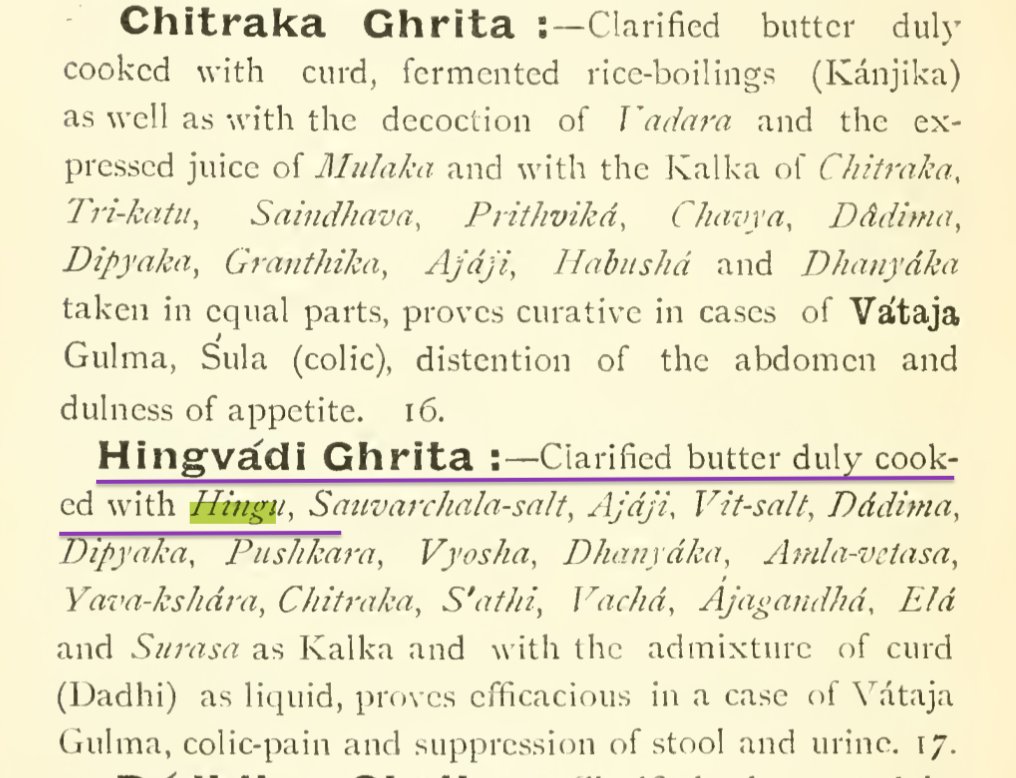1.
Hing was NOT introduced to India by Mughals in the 16th century. It was used in Ayurveda & Bharatiya cuisine 1000s of years before Islam, even by currently accepted Western dating of Indian history.
Hing was NOT introduced to India by Mughals in the 16th century. It was used in Ayurveda & Bharatiya cuisine 1000s of years before Islam, even by currently accepted Western dating of Indian history.

2.
Rishi Shukracharya (pre Mahabharata), in his Sukraniti, classifies 10 branches of medical arts, one entire branch is about making preparations with exudations like Hing. The Sukraniti is mentioned by Chanakya & predates Arthashastra (300 BCE)
Rishi Shukracharya (pre Mahabharata), in his Sukraniti, classifies 10 branches of medical arts, one entire branch is about making preparations with exudations like Hing. The Sukraniti is mentioned by Chanakya & predates Arthashastra (300 BCE)

3.
Ancient Sanskrit Ayurvedic texts Sushruta Samhita (1000-600 BCE) & Charaka Samhita (400-200 BCE) clearly refer to complex formulations with Hingu. Specific Ghees were prepared with it for various conditions.


Ancient Sanskrit Ayurvedic texts Sushruta Samhita (1000-600 BCE) & Charaka Samhita (400-200 BCE) clearly refer to complex formulations with Hingu. Specific Ghees were prepared with it for various conditions.



4.
Nala’s Paka Darpana, a cookbook by King Nala which predates the Mahabharata describes numerous recipes using Hingu for preparing Dals, meat & rice stews & vegetables. The variety of techniques indicate it was an integral part of Bharatiya cuisine far before his time.

Nala’s Paka Darpana, a cookbook by King Nala which predates the Mahabharata describes numerous recipes using Hingu for preparing Dals, meat & rice stews & vegetables. The variety of techniques indicate it was an integral part of Bharatiya cuisine far before his time.


5.
Abhilashitartha Chintamani or Manasollasa ,(12th c. CE), a cultural Sanskrit text by the Kalyani Chalukya king Someshvara III, also mentions cooking extensively with Hing to flavor such South Indian delicacies as Dhosikas (dosa), black eyed peas, dals, & even meat dishes.
Abhilashitartha Chintamani or Manasollasa ,(12th c. CE), a cultural Sanskrit text by the Kalyani Chalukya king Someshvara III, also mentions cooking extensively with Hing to flavor such South Indian delicacies as Dhosikas (dosa), black eyed peas, dals, & even meat dishes.

6.
Baseless lies claiming Hing was brought by Mughals are clearly contradicted by history. Another myth credits Alexander for bringing Hing to India from Afghanistan. But Hindu texts clearly mention cooking with Hingu from ancient Vahlika (Afghanistan), centuries before Alexander
Baseless lies claiming Hing was brought by Mughals are clearly contradicted by history. Another myth credits Alexander for bringing Hing to India from Afghanistan. But Hindu texts clearly mention cooking with Hingu from ancient Vahlika (Afghanistan), centuries before Alexander

7.
The continuity of references to Hing are evidenced by Jain scholar Hemachandra’s (12th c. CE) Nighantushesa which existed centuries before the Mughal Empire. It clearly mentions the best quality Hing as coming from Balkh or Vahlika (now Afghanistan).
The continuity of references to Hing are evidenced by Jain scholar Hemachandra’s (12th c. CE) Nighantushesa which existed centuries before the Mughal Empire. It clearly mentions the best quality Hing as coming from Balkh or Vahlika (now Afghanistan).

8.
In 1563 CE, Portugese doctor, Garcia De Orta wrote “Colloquies on the simples & drugs of India” in Goa mentioning Hing as most used by Hindus all over India. Goa was under Portuguese rule before Mughals. This clearly proves Hing was used in Hindu cuisine before the Mughals.
In 1563 CE, Portugese doctor, Garcia De Orta wrote “Colloquies on the simples & drugs of India” in Goa mentioning Hing as most used by Hindus all over India. Goa was under Portuguese rule before Mughals. This clearly proves Hing was used in Hindu cuisine before the Mughals.

9.
Ayurveda prescribes Hing for helping appetite & digestion. Indian cuisine has by far many more recipes using Hing than any other cuisine, because it was an integral part of Bharatiya culture for centuries before the Mughals or Arabs ever knew about Hing.
Ayurveda prescribes Hing for helping appetite & digestion. Indian cuisine has by far many more recipes using Hing than any other cuisine, because it was an integral part of Bharatiya culture for centuries before the Mughals or Arabs ever knew about Hing.
10.
Moreover, Hing called Asafoetida in English, is etymologically derived from asa, a latinised form of Persian azā, meaning 'mastic', & Latin foetidus meaning 'smelling, fetid’. If Hing was introduced by the Mughals - Bharatiyas would refer to it by the Persian Azā not Hingu.
Moreover, Hing called Asafoetida in English, is etymologically derived from asa, a latinised form of Persian azā, meaning 'mastic', & Latin foetidus meaning 'smelling, fetid’. If Hing was introduced by the Mughals - Bharatiyas would refer to it by the Persian Azā not Hingu.
10.
It has become common to constantly distort Bharat’s history by attributing most of our cultural heritage to foreign invaders like the Mughals or Greeks. It’s time we start fighting back with historical facts to disprove & call out such blatant lies to hijack our history.
It has become common to constantly distort Bharat’s history by attributing most of our cultural heritage to foreign invaders like the Mughals or Greeks. It’s time we start fighting back with historical facts to disprove & call out such blatant lies to hijack our history.
• • •
Missing some Tweet in this thread? You can try to
force a refresh






















































